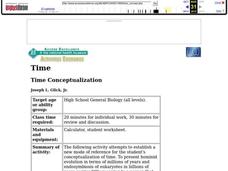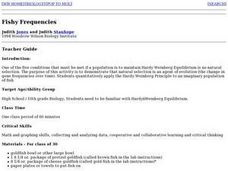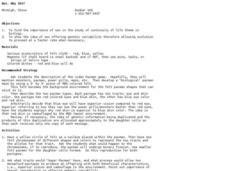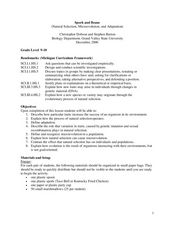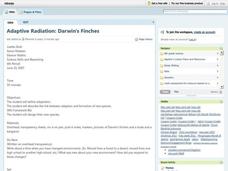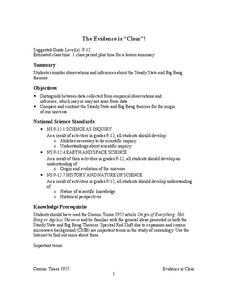Curated OER
The Rise and Fall of the Mammoths
Students develop an understanding of the evolution of species in the context of the woolly mammoth. They examine the fossil record to explain natural selection.
Curated OER
Selection and Variation in the Egyptian Origami Bird
Students investigate genetics and evolution of species. They simulate the breeding of birds using origami birds. In addition, using dice they introduce genetic variation into the species.
Curated OER
Time Conceptualization
High schoolers use this activity to establish a new mode of reference to the conceptualization of time. To present hominid evolution in terms of millions of years and endosymbiosis of eukaryotes in billions of years carries little...
Curated OER
Mimicry: An Example of Adaptation
Students are able to explain the relationship between adaptation and ability for survival and reproduction. They are able to give examples of a series of adaptations that would support the idea that evolution is a series of minor...
Curated OER
M & M Lab
Students investigate how selection occurs in a random population. The concept is that selection affects evolution.They demonstrate how selection occurs and will analyze shifts in the populations. They design their conclusions with M...
Curated OER
Fishy Frequencies
Tenth graders demonstrate that natural selection is an agent of evolution. They quantitatively apply the Hardy-Weinberg Principle to an imaginary population of fish. They utilize math and graphing skills, collecting and analyzing data,...
Curated OER
The Peppered Moth
In this evolution worksheet, students read about the changes the peppered moth went through over 100 year time period. Students complete 3 short answer questions based on what they read.
Curated OER
But, Why Sex?
Learners investigate the importance of sexual reproduction in evolution. In this sexual reproduction lesson plan, students simulate species with two traits: eye and skin color. They determine what characteristics are beneficial for the...
Curated OER
Spork and Beans
Students examine natural selection, how it works and how it can cause microevolution. In this evolution lesson students complete a lab activity that shows the effects that natural selection has on organisms.
Curated OER
Darwin's Finches
Seventh graders engage in a study of the Theory Of Evolution with the use of Darwin's finches as examples while making a connection to adaptive radiation. They use class discussion in order to further the lesson plan and focus upon...
Curated OER
Introduction To Natural Selection
Seventh graders investigate the concept of natural selection and it relation to the theory of evolution. They create a definition for classification based upon looking at other subjects that are similar. The variation of species is...
NASA
The Evidence is “Clear”!
Do you think you know better? Become a scientist and prove it. Scholars review the evidence for two different theories of the origins of the universe. They notice the empirical observations as well as the inferences to determine which is...
Curated OER
All in the Family: Calculating Cousins
Students view pictures of distant "cousins" to humans. They place them in order by their distance from humans. Students receive a packet of six pages featuring graphics and a cousins summary page. They work in groups to complete 5 cousin...
Curated OER
The History of Life on Earth
Using meters as years, your class works together to map out the geologic time scale on a football field. Plenty of background information is included in this lesson plan as well as several resource links and a student worksheet. Your...
Curated OER
Gaia: The Wisdom of the Earth
Learners are introduced to Gaia theory of natural homeostasis. They graph Earth's temperatures over time, construct terrariums or monitor the outdoor environment. Related videos titles are suggested, but may be outdated. The objectives...
Curated OER
How Does Evolution Work?
Students pretend they are a scientist like John Endler in this Web activity. They visit his pools, from hypotheses, and test them out. In the process, the explore about natural selection and sexual selection. They are able to explain the...
Curated OER
Evolution and Antibiotic Resistance
Pupils investigate the increasing problem of antibiotic resistance in such menacing diseases as tuberculosis and influenza. They take on the role of staff at a public health agency who are trying to communicate the problem to the public.
Curated OER
The Fossil Evidence for Evolution
Learners explore how scientists use fossils to explore how various species have evolved over time. In this fossil lesson students study how to date fossils.
Curated OER
Charles Darwin
Students produce a newspaper describing the times during which Charles Darwin introduced the theory of natural selection. In this evolution activity, students make observations and explore the role of observation in Charles Darwin's...
Curated OER
Fossils 2: Uncovering The Facts
Students recognize the kind of information that can be accumulated by studying dinosaur fossils, and explain that some fossil facts are made based on comparisons with living organisms. They are introduced to the concept of evolution.
Curated OER
Bird Land
Students role-playing the concept of evolution through naturally occurring mutations. Working in pairs, they model how birds have adapted to the food sources in their environment through changes in their beak size and shapes. Students...
Curated OER
Using Team Games Tournaments
Students review the unit on evolution and natural selection by playing a card game. Students take turns drawing a card from the stack and reading the question out aloud. The reader gives an answer. The other students, in turn may pass or...
Curated OER
The Six Kingdoms
In this evolution worksheet, learners will determine the evolutionary relationships among organisms using cladograms and phylogenetic diagrams. This worksheet has 13 short answer questions and 3 multiple choice questions.
Curated OER
GED Vocabulary: Life Science
In this life science GED learning exercise, students complete a crossword puzzle given 9 clues about structures of the nervous system, the circulatory system, evolution, the digestive system, molecules and fossils. Students are given a...




